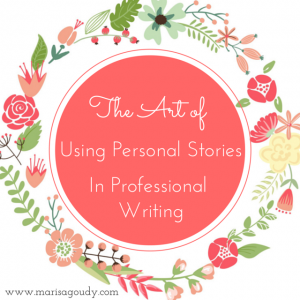The Art of Using Personal Stories In Professional Writing
 Sharing bits of your own life can be an ideal way to connect with your reader and show that you’re delightfully (or horribly!) human.
Then again, it can be a risk. Sharing too much or nattering on about something that bores your audience can kill engagement and lead to unsubscribes.
Sharing bits of your own life can be an ideal way to connect with your reader and show that you’re delightfully (or horribly!) human.
Then again, it can be a risk. Sharing too much or nattering on about something that bores your audience can kill engagement and lead to unsubscribes.
As with anything, it’s about striking the right balance. For the creative entrepreneur, that means blending a story that piques interest with useful information your readers can apply to their own lives.
Your mission: weave together story & news they can use
Two general guidelines as you balance story and practical information in your business writing:
- Provide just-juicy-enough details and personal revelations, while honoring that this is a professional space, not a confessional one.
- Remember that the reader is the hero, not you (even if you’re using your own crumby day or ecstatic moment to get an idea across). The article you’re writing or the talk you’re giving may open with lots of “I did this…” and then “I thought that…” language, but you want to bring it back to the “you” by the end of the piece.
Does every personal story need to offer the reader an obvious “what’s in it for me?”
Just as balance isn’t always about 50/50, “make your own story about the reader” isn’t true 100% of the time - at least not in an overt way.
Business writing and blogging isn’t memoir writing, but we can take a cue from the Elizabeth Gilberts and Cheryl Strayeds of the world… Even when the story is purely personal, strangers can see their own story in a first person narrative.
If you trust your readership to interpret the story and understand that they can follow your example or heed a cautionary tale, you may be able to carry the autobiographical approach all the way to end.
When you’re starting out, however, stick with this basic rule: employ a compelling story from your own life to illuminate something you’d like your readers to examine or try in their own lives.
- Be obvious about the connection between story and "lesson."
- Transition from prose to a list. (This makes it clear for the reader that they're in the "teaching bit" of the article.)
- Shift from using“I” at beginning to using “you” at the end.
Interested in seeing that in action? I walked my talk in last week’s Sovereign Standard post: As Entrepreneurs, As Writers, As Mothers: What’s “Enough”?
Did you know it was possible to take the story of a fourteen month old’s split lip and use it to describe how to best prioritize your business writing? I didn’t either…
But, as I worked through the worry and the guilt that sprang from failing to protect my girl (from gravity and a wee bit of questionable maternal judgment), I eventually arrived at secure state of “enoughness.”
And "enoughness" isn't just essential to the harried mama - it's essential for the overcommitted entrepreneur trying to honor client work and business building and the writing practice that feeds her soul as well as her marketing duties.
Learn how the Story Triangle can help you balance TMI and just enough details to draw your readers in. Sign up for the free webinar.
